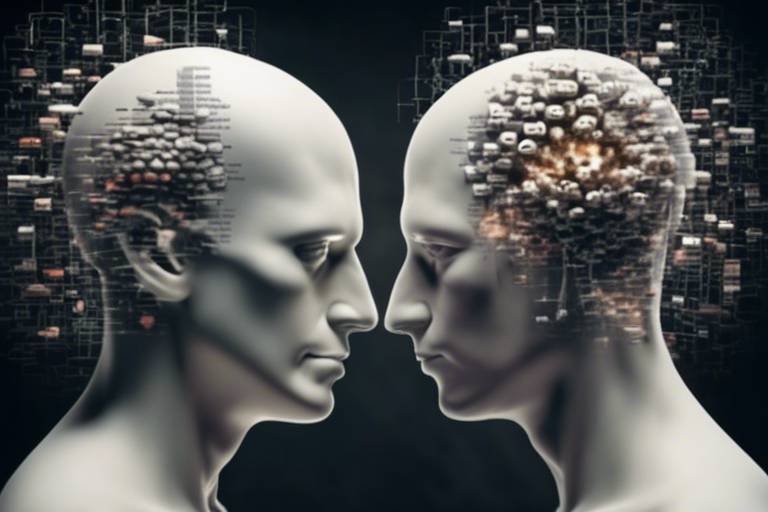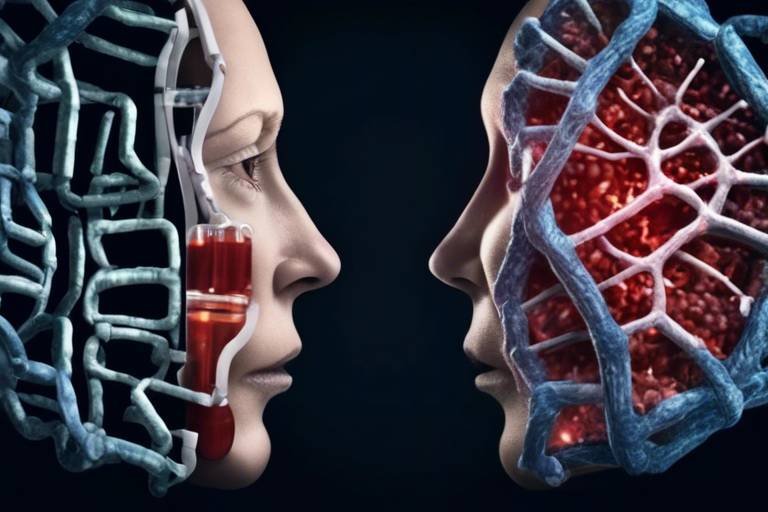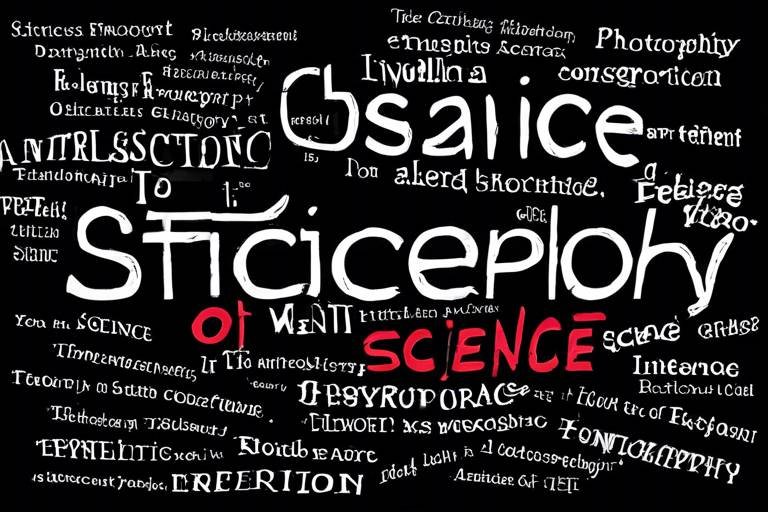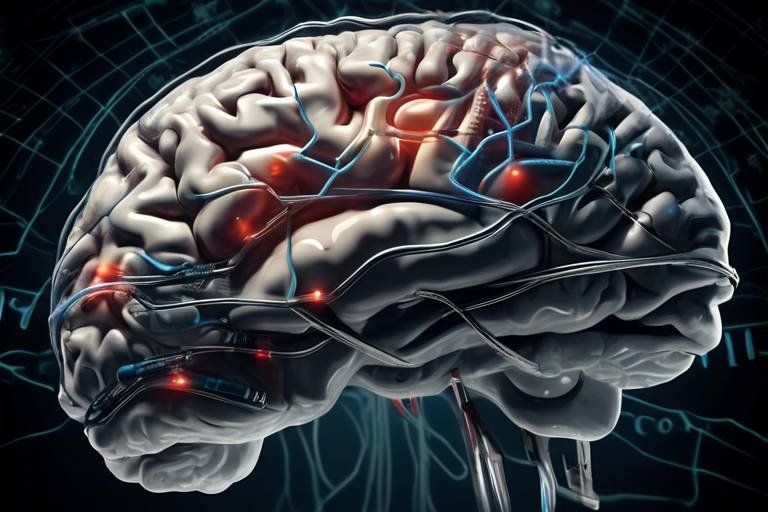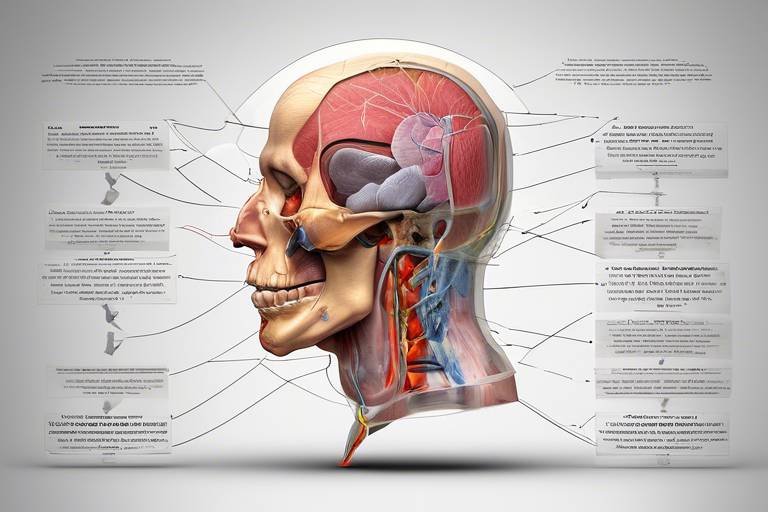The Philosophy of Cognitive Science - Leaving Dualism Behind
Cognitive science is a fascinating field that dives deep into the intricacies of the mind and intelligence. It’s a melting pot of various disciplines, including psychology, neuroscience, philosophy, linguistics, and artificial intelligence. This article will take you on a journey through the evolution of cognitive science, particularly focusing on how it has gradually shifted away from the traditional dualistic perspectives that have dominated philosophical thought for centuries. But why is this shift so important? What does it mean for our understanding of consciousness and the mind-body relationship? Let’s unravel these questions together.
At its core, cognitive science seeks to unravel the mysteries of how we think, learn, and perceive the world around us. Unlike traditional philosophical approaches that often draw a clear line between mind and body, cognitive science embraces a more holistic view. It challenges the notion that the mind operates independently of the body, suggesting instead that our physical experiences significantly shape our mental processes. This perspective is not just revolutionary; it’s essential for a comprehensive understanding of human cognition. Imagine your mind as a garden, where every experience is a seed that grows into a unique plant. The more diverse the seeds, the richer the garden becomes.
Dualism, the idea that mind and body are separate entities, has been a cornerstone of philosophical discourse for centuries. But as we delve into the depths of cognitive science, we find that this separation is becoming increasingly untenable. Historical figures like René Descartes have laid the groundwork for dualistic thought, positing that the mind is a non-physical substance distinct from the body. However, as cognitive science evolves, so does our understanding of this age-old debate. Are we really just minds trapped in physical bodies, or is there a more unified way to think about our existence?
To understand the impact of dualism, we must first look back at its historical roots. Philosophers like Descartes not only shaped the way we think about the mind but also influenced countless generations of thinkers who followed. His famous declaration, “Cogito, ergo sum” (I think, therefore I am), suggests that the act of thinking is the essence of existence. Yet, this perspective has faced significant challenges from modern neuroscience and psychology, which argue for a more integrated approach to understanding human experience.
René Descartes’ contributions to philosophy cannot be overstated. His exploration of the mind-body relationship established a framework that many still refer to today. However, while his ideas sparked a rich dialogue about the nature of consciousness, they also set the stage for a rigid separation that modern cognitive science seeks to dismantle. As we explore the implications of his work, we find ourselves asking: can we truly understand the mind without considering the body?
Critics of dualism argue that it fails to account for the complex interactions between mind and body. Neuroscientific research has shown that mental states can influence physical states and vice versa. For instance, consider the phenomenon of stress: it can manifest physically in our bodies, affecting our health and well-being. This interplay challenges the dualistic view, urging us to adopt a more unified understanding of cognition. In essence, the mind is not a ghost in the machine; it is deeply intertwined with our bodily experiences.
As cognitive science progresses, many scholars advocate for a monistic perspective, which posits that mind and body are not separate entities but rather two aspects of the same reality. This shift has profound implications for our understanding of consciousness. If we embrace a monistic view, we open ourselves up to a richer understanding of human experience, one that acknowledges the intricate connections between our thoughts, feelings, and physical states. It’s like realizing that the ocean and the waves are not separate; they are part of the same vast body of water.
Embodied cognition is a groundbreaking perspective that emphasizes the role of the body in shaping the mind. This approach challenges traditional dualistic notions and supports a more integrated understanding of cognition. By recognizing that our bodily experiences influence our thoughts and emotions, we can better appreciate the complexity of human cognition. Imagine trying to understand a symphony without considering the instruments; the beauty of music lies in the interplay of sounds, just as the richness of cognition lies in the interplay of mind and body.
Several key theories and research findings illustrate the importance of bodily experiences in cognitive processes. For instance, studies have shown that physical actions can enhance learning and memory retention. When we engage our bodies in the learning process—through gestures, movements, or even role-playing—we create more robust neural connections that support our cognitive development. It’s as if our bodies are the stage on which our minds perform, and the more dynamic the performance, the richer the understanding.
The implications of embodied cognition extend far beyond academic discourse. In real-world applications, this perspective influences areas such as education, therapy, and artificial intelligence. For example, educators are increasingly incorporating movement-based learning strategies to enhance student engagement and retention. Similarly, therapists are recognizing the importance of bodily awareness in mental health treatment, helping clients connect their physical sensations with emotional experiences. In the realm of artificial intelligence, understanding embodied cognition can lead to the development of more intuitive and human-like machines. The future of cognitive science is not just about understanding the mind; it's about embracing the body as an integral part of that understanding.
- What is cognitive science? Cognitive science is an interdisciplinary field that studies the mind and intelligence, incorporating insights from psychology, neuroscience, philosophy, and more.
- What is the difference between dualism and monism? Dualism posits that mind and body are separate entities, while monism argues that they are interconnected aspects of the same reality.
- How does embodied cognition influence learning? Embodied cognition suggests that physical actions and experiences enhance cognitive processes, leading to better learning outcomes.
- What are the practical applications of embodied cognition? This perspective influences various fields, including education, therapy, and artificial intelligence, by promoting a more integrated approach to understanding human experience.

Understanding Cognitive Science
Cognitive science is like a thrilling adventure into the depths of the mind, where various disciplines converge to explore the intricacies of thought, perception, and intelligence. Imagine embarking on a journey that combines psychology, neuroscience, linguistics, philosophy, and artificial intelligence all in one. That's what cognitive science offers—a comprehensive framework for understanding how we think, learn, and interact with the world around us.
At its core, cognitive science seeks to unravel the mysteries of the mind by asking fundamental questions: What is consciousness? How do we process information? What role does the brain play in shaping our thoughts and behaviors? These inquiries challenge the traditional philosophical views that have long dominated discussions about the mind, particularly the dualistic perspective that separates the mind from the body.
One of the foundational concepts in cognitive science is the idea that cognition is not just a product of the brain but is also influenced by our environment and bodily experiences. This perspective is crucial because it shifts the focus from viewing the mind as an isolated entity to understanding it as a dynamic system that interacts with the world. For instance, when we learn a new skill, our body is not just a vessel; it actively participates in the learning process. This integration of body and mind is a hallmark of cognitive science, highlighting the importance of an interdisciplinary approach.
Moreover, cognitive science employs various methodologies to study the mind, ranging from experimental psychology to neuroimaging techniques. These methods allow researchers to observe brain activity in real-time, providing insights into how different cognitive processes unfold. For example, using functional MRI (fMRI), scientists can visualize which areas of the brain are activated during specific tasks, revealing the complex interplay between thought and neural activity.
In essence, cognitive science is a vibrant and evolving field that challenges us to rethink our understanding of the mind. By moving beyond dualistic notions, it encourages a more holistic view that recognizes the interconnectedness of our mental processes, bodily experiences, and environmental contexts. This shift not only enriches our understanding of cognition but also opens up new avenues for research and application in various domains, including education, therapy, and artificial intelligence.
As we delve deeper into the philosophy of cognitive science, we begin to appreciate how this interdisciplinary approach is reshaping our understanding of consciousness and the human experience. So, buckle up as we explore the fascinating world of cognitive science and its implications for the future!

The Dualism Debate
The dualism debate is a captivating and often contentious topic in the realms of philosophy and cognitive science. At its core, dualism suggests a distinct separation between the mind and the body, positing that our mental states and physical states exist independently of one another. This idea has been a cornerstone of philosophical inquiry for centuries, but as cognitive science evolves, so does our understanding of this complex relationship. The implications of dualism are profound, influencing how we perceive consciousness, self-awareness, and even artificial intelligence. But the question remains: can we truly separate the mind from the body, or are they two sides of the same coin?
Historically, dualism can be traced back to the influential works of philosophers like René Descartes, who famously declared, "Cogito, ergo sum" or "I think, therefore I am." Descartes' assertion laid the groundwork for the idea that the mind, as a non-physical entity, interacts with the physical body in a way that is not entirely understood. This belief has permeated philosophical discourse, creating a dichotomy that many contemporary thinkers challenge. As cognitive science progresses, it becomes increasingly clear that this division may be more of a conceptual convenience than a reflection of reality.
Critiques of dualism have emerged from various fields, particularly neuroscience and psychology, which argue for a more integrated understanding of cognition. For instance, neuroscientific research has shown that mental processes are deeply intertwined with brain activity, suggesting that our thoughts, emotions, and consciousness are not separate from our physical being. This perspective aligns with the growing trend towards monism, which proposes that mind and body are not distinct entities but rather two aspects of a unified whole. The shift towards monism invites a re-examination of how we understand cognition, urging us to consider the intricate connections between our mental states and our physical experiences.
In summary, the dualism debate is not just an academic exercise; it has real-world implications for how we understand ourselves and our interactions with the world. As cognitive science continues to challenge traditional dualistic perspectives, we are encouraged to explore a more holistic view of the mind-body relationship. This evolution in thought not only enriches our understanding of consciousness but also opens new avenues for research and application in various fields, from psychology to artificial intelligence.
- What is dualism? Dualism is the philosophical position that separates the mind and body as distinct entities, suggesting that mental phenomena are non-physical.
- Who is a key figure in the dualism debate? René Descartes is a pivotal figure, known for his assertion of the separation between mind and body.
- What are the critiques of dualism? Critics argue that dualism oversimplifies the relationship between mind and body, as neuroscience reveals their interconnectedness.
- What is monism? Monism is the belief that mind and body are not separate but two aspects of a single entity.

Historical Roots of Dualism
To truly grasp the implications of dualism in cognitive science, we must journey back in time to its historical roots. Dualism, the idea that the mind and body are distinct entities, has been a central theme in philosophical discourse for centuries. This notion was notably championed by the French philosopher René Descartes in the 17th century. Descartes famously posited that the mind, a non-physical entity, interacts with the body, a physical one, through the pineal gland. This groundbreaking idea laid the groundwork for what would become a long-standing debate in philosophy and science.
Descartes' perspective was revolutionary; he argued that the mind is a realm of thought, distinct from the corporeal world. His famous dictum, "I think, therefore I am," encapsulated his belief in the primacy of the mind. However, this separation raised critical questions: If the mind and body are separate, how do they interact? This question has haunted philosophers and scientists alike, leading to numerous interpretations and critiques of dualism over the years.
Fast forward to the 20th century, and we see a shift in the conversation. As advances in neuroscience and psychology emerged, the dualistic perspective began to face serious challenges. Researchers started to uncover the intricate ways in which mental processes are linked to physical states. For instance, studies on brain injuries revealed that specific areas of the brain are responsible for particular cognitive functions, suggesting a more integrated approach to understanding the mind-body relationship.
Moreover, the rise of behaviorism in the early 20th century further questioned dualistic assumptions. Behaviorists focused on observable behaviors rather than internal mental states, arguing that psychology should be rooted in empirical evidence. This shift towards a more unified understanding of cognition paved the way for contemporary cognitive science, which seeks to bridge the gap between the mind and body.
In summary, the historical roots of dualism are deeply intertwined with the evolution of philosophical thought. While Descartes' ideas laid a foundation, the subsequent critiques and advancements in science have prompted a reevaluation of the mind-body relationship. As we delve deeper into cognitive science, we find ourselves moving away from the rigid boundaries of dualism towards a more integrated perspective that acknowledges the complex interplay between mind and body.

Descartes' Influence
René Descartes, often hailed as the father of modern philosophy, made profound contributions to our understanding of the mind-body relationship. His famous dictum, "I think, therefore I am," encapsulates his belief in the primacy of thought as a defining characteristic of human existence. Descartes proposed a dualistic framework, suggesting that the mind and body are fundamentally different substances: the body is physical and operates in the realm of the material world, while the mind is immaterial and exists in a separate domain. This separation has significantly influenced philosophical discourse, leading to a schism in how we understand consciousness and cognition.
Descartes' dualism laid the groundwork for numerous debates in cognitive science, particularly regarding the nature of consciousness. His assertion that the mind interacts with the body through the pineal gland was groundbreaking for its time, yet it also raised questions about how two such distinct substances could interact. This dilemma has sparked a plethora of critiques and alternative theories, ultimately pushing cognitive scientists to seek a more integrated understanding of mind and body.
Moreover, Descartes' influence extends beyond philosophy into the realms of psychology and neuroscience. His ideas prompted thinkers to explore the implications of a divided self, leading to inquiries into how emotions, thoughts, and physical states interact. For instance, consider how stress can manifest physically through tension headaches or how physical exercise can enhance mental clarity. These connections challenge the rigid boundaries Descartes established and suggest a more fluid relationship between mind and body.
To illustrate Descartes' lasting impact, we can summarize his key contributions and their implications in the following table:
| Contribution | Description | Implications |
|---|---|---|
| Mind-Body Dualism | Separation of mind and body into distinct entities. | Led to debates on consciousness and the nature of self. |
| Pineal Gland Interaction | Proposed the pineal gland as the point of interaction. | Raised questions about the nature of substance interaction. |
| Foundation of Modern Philosophy | Established the importance of rational thought. | Influenced both philosophical and scientific methodologies. |
Despite the historical significance of Descartes' ideas, contemporary cognitive science increasingly critiques dualism, advocating for a more integrated approach. As researchers delve deeper into the complexities of cognition, they recognize that the mind cannot be fully understood in isolation from the body. This shift away from dualistic thinking towards a more holistic perspective is essential in unraveling the mysteries of human consciousness and intelligence.
- What is dualism? Dualism is the philosophical concept that the mind and body are separate and fundamentally different substances.
- How did Descartes influence cognitive science? Descartes' ideas about mind-body separation prompted debates and critiques that led to more integrated approaches in understanding cognition.
- What is the significance of embodied cognition? Embodied cognition emphasizes the role of bodily experiences in cognitive processes, challenging the traditional dualistic views.

Critiques of Dualism
The concept of dualism, which asserts a fundamental separation between the mind and the body, has faced significant scrutiny over the years. Critics argue that this perspective is not only outdated but also fails to account for the complexities of human experience and cognition. One of the most compelling critiques comes from the field of neuroscience, which has made remarkable strides in understanding how brain activity correlates with mental states. For instance, when we engage in a thought process, specific neural pathways are activated, suggesting that our mental experiences are deeply rooted in biological processes. This challenges the dualistic notion that the mind exists independently of the physical body.
Moreover, philosophers like Daniel Dennett and Patricia Churchland have articulated strong arguments against dualism by emphasizing the importance of a unified theory of mind. Dennett, in particular, suggests that consciousness is a product of evolutionary processes, and thus, it cannot be divorced from the physical brain. He famously argues that consciousness should be viewed as a "user illusion," a metaphor that implies our perception of a separate mind is merely a convenient narrative constructed by our brains. This perspective encourages us to rethink how we define consciousness and its relationship to our physical selves.
Another significant critique of dualism is its inability to explain how two seemingly distinct substances—mind and body—interact. This is often referred to as the “interaction problem.” If the mind is non-physical, how do thoughts influence bodily actions? This question remains unanswered within the dualistic framework, leading many to favor a more monistic approach that sees mind and body as interconnected. For example, when we feel anxious (a mental state), our body responds with physiological changes, such as increased heart rate and sweating. This interplay suggests a more integrated relationship between mental and physical states.
Furthermore, advancements in psychology and cognitive science have revealed that our cognitive processes are not isolated events but are influenced by our environment and physical interactions. The theory of embodied cognition posits that our bodily experiences shape our thoughts and perceptions, further undermining the dualistic viewpoint. By recognizing that our cognitive abilities are grounded in our physical experiences, we can better understand how we interact with the world around us.
In summary, the critiques of dualism highlight its limitations in explaining the complexities of the mind-body relationship. As cognitive science continues to evolve, it increasingly supports a more integrated view that acknowledges the interplay between our mental states and physical experiences. This shift not only enhances our understanding of consciousness but also opens up new avenues for research and application in various fields, from psychology to artificial intelligence.
- What is dualism? Dualism is the philosophical view that the mind and body are distinct entities that interact with each other.
- Why is dualism criticized? Critics argue that dualism fails to explain the interaction between mind and body and does not account for findings in neuroscience that show a close relationship between mental states and brain activity.
- What is embodied cognition? Embodied cognition is a theory suggesting that our cognitive processes are deeply rooted in our bodily experiences and interactions with the environment.
- How does cognitive science challenge dualism? Cognitive science emphasizes the interconnectedness of mental and physical processes, advocating for a more unified understanding of consciousness.

Moving Towards Monism
As we venture deeper into the fascinating realm of cognitive science, one of the most compelling shifts we observe is the transition towards monism. This perspective posits that mind and body are not separate entities but rather two aspects of a single reality. It’s like viewing a coin; while it has two distinct sides, they are inseparable from one another. This evolving understanding challenges the traditional dualistic views that have dominated philosophical discourse for centuries.
Monism invites us to reconsider our understanding of consciousness and cognition. Instead of seeing the mind as an isolated phenomenon, it encourages us to recognize how our physical experiences shape our mental processes. For instance, consider how emotions are often tied to physiological responses. When we feel joy, our bodies react with smiles and laughter; when we experience stress, our heart races and our muscles tense. This interplay illustrates that our mental states are deeply intertwined with our physical states, suggesting that a comprehensive understanding of cognition requires a unified approach.
Moreover, the implications of adopting a monistic perspective extend beyond the academic realm. In practical terms, it influences various fields, from psychology to artificial intelligence. For instance, in therapy, practitioners increasingly recognize the importance of addressing both mental and physical health. Techniques such as mindfulness and somatic therapies emphasize the connection between body and mind, fostering a holistic approach to healing.
At its core, monism aligns with findings from neuroscience, which reveals how brain activity correlates with mental states. Advances in neuroimaging technologies have allowed researchers to observe the brain in action, providing insights into how our thoughts and feelings manifest physically. This evidence supports the idea that cognition cannot be fully understood without considering the biological underpinnings that give rise to it.
In summary, the move towards monism in cognitive science represents a profound shift in how we conceptualize the relationship between mind and body. By embracing this integrated perspective, we can gain a deeper understanding of consciousness, paving the way for more effective approaches in various disciplines. As we continue to explore this exciting territory, one thing is clear: the future of cognitive science will likely be defined by the unity of mind and body, rather than their separation.
- What is the main difference between dualism and monism?
Dualism posits that mind and body are separate entities, while monism argues that they are two aspects of the same reality. - How does embodied cognition relate to monism?
Embodied cognition emphasizes the role of the body in shaping mental processes, aligning closely with monistic views that reject the separation of mind and body. - Why is the shift towards monism significant?
This shift is significant as it opens up new avenues for understanding consciousness and has practical implications in fields like therapy and education.

Embodied Cognition
Embodied cognition is a fascinating concept that challenges the traditional views of how we understand the mind. It suggests that our cognitive processes are deeply rooted in our physical experiences and interactions with the world around us. Think about it: when you learn something new, your body is often involved in the process. Whether it's riding a bike, playing an instrument, or even just recalling a memory, your body plays an integral role in shaping your thoughts and understanding. This perspective flips the script on the old dualistic notion that the mind and body are separate entities, emphasizing instead that they are intricately linked.
At the heart of embodied cognition is the idea that our mental processes are not just confined to the brain but are influenced by our sensory and motor experiences. Imagine trying to learn how to dance without moving your body; it would be nearly impossible! This illustrates how our physical actions can enhance our cognitive abilities, leading to a more holistic understanding of intelligence. In fact, research in this area has shown that engaging in physical activities can improve problem-solving skills, creativity, and even emotional regulation. It's as if our bodies are not just vessels but active participants in our cognitive journey.
One of the key theories in embodied cognition is the concept of sensorimotor grounding. This theory posits that our understanding of abstract concepts is often rooted in our physical experiences. For instance, when we think about time, we might visualize it as a linear path, reflecting our experience of moving through space. This connection between our physical experiences and our cognitive processes highlights the importance of considering the body when studying the mind.
Moreover, the implications of embodied cognition extend beyond theoretical discussions. In practical terms, this perspective has significant impacts on various fields such as education, therapy, and artificial intelligence. For example, in educational settings, incorporating movement into learning activities can enhance retention and understanding. Instead of sitting still for hours, students might engage in hands-on activities that allow them to embody the concepts they are learning. This approach not only makes learning more enjoyable but also more effective.
In therapy, embodied cognition can inform practices that help individuals connect their physical sensations with their emotions. Techniques such as mindfulness and somatic experiencing encourage people to tune into their bodies, fostering greater self-awareness and emotional regulation. This is particularly beneficial for those dealing with trauma, as it allows for a more integrated healing process.
In the realm of artificial intelligence, understanding embodied cognition can lead to the development of more sophisticated and human-like robots. By designing machines that can learn from their physical interactions with the environment, researchers can create systems that mimic human cognitive processes more closely. This could revolutionize how we interact with technology, making it more intuitive and responsive to our needs.
In summary, embodied cognition is a paradigm shift that encourages us to reconsider the relationship between mind and body. By acknowledging the role of our physical experiences in shaping our thoughts, we open the door to a more integrated understanding of cognition. This shift not only challenges traditional dualistic views but also offers practical applications that can enhance learning, therapy, and technology. As we continue to explore this exciting field, the possibilities for understanding the human experience become even more profound.
- What is embodied cognition? Embodied cognition is the theory that our cognitive processes are deeply intertwined with our bodily experiences and interactions with the environment.
- How does embodied cognition impact learning? Engaging in physical activities during learning can enhance retention and understanding, making the process more effective.
- Can embodied cognition be applied in therapy? Yes, techniques that focus on connecting physical sensations with emotions can promote greater self-awareness and emotional regulation.
- What are the implications for artificial intelligence? Understanding embodied cognition can lead to the development of more advanced robots that learn from physical interactions, making them more intuitive.

Key Theories in Embodied Cognition
Embodied cognition is a fascinating field that challenges traditional notions of how we understand the mind. It posits that our cognitive processes are deeply rooted in the body's interactions with the world. This perspective shifts the focus from a disembodied mind to one that is influenced by physical experiences and sensory input. One of the key theories in embodied cognition is the conceptual metaphor theory, which suggests that our understanding of abstract concepts is grounded in our bodily experiences. For instance, when we talk about "grasping" ideas, we're literally using a physical metaphor to describe a cognitive process. This intertwining of physical and mental experiences highlights how our bodies shape our thoughts.
Another significant theory is the enactive approach, which argues that cognition arises through a dynamic interaction between an organism and its environment. This theory emphasizes that perception is not merely a passive reception of stimuli but an active engagement with the world. The enactive approach suggests that our understanding of reality is constructed through our bodily interactions, making it a participatory process rather than a solitary one. Imagine learning to ride a bike; it’s not just about understanding balance theoretically but about the physical act of riding, falling, and adjusting your body accordingly. This illustrates how cognition is not isolated in the brain but is a holistic experience involving the whole body.
Additionally, the embodied simulation theory posits that our understanding of others' actions and emotions is grounded in our own bodily experiences. When we see someone smiling, our brain activates similar neural pathways as if we were experiencing that smile ourselves. This phenomenon suggests that our capacity for empathy and social understanding is intricately linked to our bodily experiences. It’s as if our bodies serve as a mirror, reflecting the emotions and actions of those around us, thereby enriching our social interactions.
To illustrate these theories, let’s take a look at a table that summarizes their core principles and implications:
| Theory | Core Principle | Implication |
|---|---|---|
| Conceptual Metaphor Theory | Cognitive understanding is grounded in bodily experiences. | Language and thought are intertwined with physical actions. |
| Enactive Approach | Cognition arises from interaction with the environment. | Learning is an active, participatory process. |
| Embodied Simulation Theory | Understanding others is rooted in our own bodily experiences. | Empathy and social cognition are enhanced through bodily engagement. |
These theories collectively underscore the importance of the body in shaping our cognitive processes. They challenge the traditional view that separates mind and body, advocating instead for a more integrated approach to understanding cognition. As we delve deeper into embodied cognition, we open up new avenues for research and application, particularly in fields like education, therapy, and artificial intelligence.
In conclusion, the exploration of these key theories not only enriches our understanding of cognition but also emphasizes the profound connection between our physical selves and our mental processes. By embracing these ideas, we can develop more effective strategies for learning and interacting with the world around us.
- What is embodied cognition? Embodied cognition is the theory that our cognitive processes are deeply rooted in our bodily interactions with the world.
- How does embodied cognition differ from traditional cognitive theories? Traditional theories often separate mind and body, while embodied cognition emphasizes their interconnectedness.
- Can embodied cognition influence education? Yes, understanding embodied cognition can lead to more effective teaching methods that engage students physically and mentally.

Practical Implications
The concept of embodied cognition isn’t just an abstract theory confined to the walls of academia; it has real-world applications that can transform various fields. Imagine a classroom where students aren't just passive recipients of information but are actively engaged in their learning through physical activities. This is one of the most exciting implications of embodied cognition in education. By integrating movement and sensory experiences into learning, educators can enhance memory retention and understanding. Research has shown that when students use their bodies to explore concepts—like acting out a story or conducting experiments—they grasp the material more deeply. Isn’t that a game-changer for traditional teaching methods?
Moreover, in the realm of therapy, embodied cognition offers innovative approaches to mental health treatment. Therapists are increasingly recognizing the importance of the body in emotional regulation and cognitive processes. Techniques such as mindfulness, yoga, and somatic experiencing encourage clients to reconnect with their physical sensations, effectively bridging the gap between mind and body. This holistic approach not only aids in the treatment of anxiety and depression but also promotes overall well-being. Picture a therapy session that incorporates movement and breathwork instead of just sitting on a couch talking—how refreshing is that?
Another fascinating area where embodied cognition is making waves is in artificial intelligence. As AI continues to evolve, researchers are looking to incorporate principles of embodied cognition into the development of more advanced systems. By designing robots and AI that can learn from physical interactions with their environment, we can create machines that not only process information but also understand context in a more human-like manner. This could lead to innovations in robotics, where machines can adapt to their surroundings and respond to human emotions more naturally. Just think about how a robot that understands human gestures and emotions could revolutionize customer service or caregiving!
To sum it up, the practical implications of embodied cognition stretch far and wide, influencing education, therapy, and technology. By acknowledging the interconnectedness of mind and body, we open the door to more effective, engaging, and holistic approaches in these fields. The shift from traditional dualistic views to a more integrated understanding is not just philosophical; it’s a pathway to real-world transformation. So, are you ready to embrace this exciting evolution in how we think about cognition?
- What is embodied cognition? Embodied cognition is the theory that our cognitive processes are deeply rooted in the body's interactions with the world. It emphasizes that our physical experiences shape our thoughts and understanding.
- How can embodied cognition improve education? By incorporating physical activities and sensory experiences into learning, students can engage more deeply with the material, leading to better retention and understanding.
- What role does embodied cognition play in therapy? It promotes a holistic approach to mental health by helping clients reconnect with their bodies, which can aid in emotional regulation and enhance therapeutic outcomes.
- Can embodied cognition be applied to artificial intelligence? Yes! Researchers are exploring how principles of embodied cognition can inform the development of AI systems that learn from physical interactions, leading to more adaptive and responsive technologies.
Frequently Asked Questions
- What is cognitive science?
Cognitive science is an interdisciplinary field that explores the nature of the mind and intelligence. It combines insights from psychology, neuroscience, artificial intelligence, philosophy, linguistics, and anthropology to understand how we think, learn, and remember.
- What does dualism mean in the context of cognitive science?
Dualism is the philosophical view that the mind and body are separate entities. This perspective, which has roots in the work of philosophers like René Descartes, suggests that mental phenomena cannot be fully explained by physical processes. However, cognitive science increasingly challenges this notion, advocating for a more integrated approach.
- How has the dualism debate influenced modern cognitive science?
The dualism debate has sparked critical discussions that have led to the development of more unified theories of mind and body. As critiques of dualism have emerged from neuroscience and psychology, cognitive science has shifted towards perspectives like monism, which posits that the mind and body are interconnected.
- What is embodied cognition?
Embodied cognition is a theory that emphasizes the role of the body in shaping cognitive processes. It suggests that our bodily experiences significantly influence how we think and perceive the world, challenging traditional dualistic views that separate mental and physical experiences.
- What are some practical applications of embodied cognition?
Embodied cognition has real-world implications in various fields, including education, therapy, and artificial intelligence. For instance, in education, understanding how physical movement can enhance learning helps develop more effective teaching strategies.
- Can you explain the critiques of dualism?
Critiques of dualism often come from neuroscience and psychology, which provide evidence that mental states are closely tied to physical processes in the brain. These critiques argue that a more holistic view of cognition can lead to better understanding and treatment of mental health issues.
- What is the significance of moving towards monism?
Moving towards monism is significant because it encourages a more integrated understanding of consciousness. By recognizing that mind and body are not separate, cognitive science can explore the complexities of human experience in a more comprehensive way, leading to advancements in both research and application.

